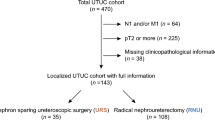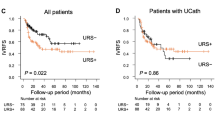Abstract
Objectives
To evaluate the cancer detection rate (CDR) of an early repeated flexible ureteroscopy (2nd-look-URS) and its impact on the conservative management of patients affected with upper urinary tract urothelial carcinoma (UTUC).
Materials and methods
Clinical and surgical data from 41 patients with UTUC who underwent 2nd-look-URS within 60 days of their first URS with concomitant laser tumour photoablation at a single tertiary care referral centre from 2009 to 2013 were retrospectively analyzed. Radical nephroureterectomy was offered during follow-up in case of massive tumour recurrence (defined as a tumour not completely removable only with a conservative approach). Descriptive statistics tested the impact of 2nd-look-URS outcomes on subsequent endoscopic evaluation. Kaplan–Meier curves assessed massive tumour recurrence-free survival (mRFS) rates according to the presence of a tumour at 2nd-look-URS. Cox regression analyses identified predictors of mRFS.
Results
CDR at 2nd-look-URS was 51.2 %. CDRs at third URS were 81.3 and 41.2 % in patients with a positive and a negative 2nd-look-URS, respectively (p = 0.02). At a mean (median) follow-up of 34.6 (27.6) months, mRFS rates were 88 and 48 % in patients with negative and positive 2nd-look-URS, respectively (log rank = 0.015). Tumour grade at first URS and 2nd-look-URS outcomes achieved predictor status for mRFS (HR 6.1, 95 % CI 1.42–26.27 and HR 5.39, 95 % CI 1.18–24.66, respectively, all p ≤ 0.03).
Conclusions
2nd-look-URS-related CDR in conservatively treated UTUC patients was 51.2 %. 2nd-look-URS outcomes affected the findings of both subsequent endoscopic evaluation and mRFS. Further studies are needed to confirm the benefits of this approach in terms of patient outcomes.

Similar content being viewed by others
References
Rouprêt M, Babjuk M, Compérat E et al (2013) European guidelines on upper tract urothelial carcinomas: 2013 update. Eur Urol 63:1059–1071
Daneshmand S, Quek ML, Huffman JL (2003) Endoscopic management of upper urinary tract transitional cell carcinoma: long-term experience. Cancer 98:55–60
Zigeuner R, Pummer K (2008) Urothelial carcinoma of the upper urinary tract: surgical approach and prognostic factors. Eur Urol 53:720–731
Gadzinski AJ, Roberts WW, Faerber GJ et al (2010) Long-term outcomes of nephroureterectomy versus endoscopic management for upper tract urothelial carcinoma. J Urol 183:2148–2153
Grasso M, Fishman AI, Cohen J, Alexander B (2012) Ureteroscopic and extirpative treatment of upper urinary tract urothelial carcinoma: a 15-year comprehensive review of 160 consecutive patients. BJU Int 110:1618–1626
Traxer O, Geavlete B, de Medina SG et al (2011) Narrow-band imaging digital flexible ureteroscopy in detection of upper urinary tract transitional-cell carcinoma: initial experience. J Endourol 25:19–23
Huffman JL, Bagley DH, Lyon ES et al (1985) Endoscopic diagnosis and treatment of upper-tract urothelial tumors. A preliminary report. Cancer 55:1422–1428
Engelmyer EI, Belis JA (1996) Long-term ureteroscopic management of low-grade transitional cell carcinoma of the upper urinary tract. Tech Urol 2:113–116
Martínez-Piñeiro JA, García Matres MJ, Martínez-Piñeiro L (1996) Endourological treatment of upper tract urothelial carcinomas: analysis of a series of 59 tumors. J Urol 156:377–385
Chen GL, Bagley DH (2000) Ureteroscopic management of upper tract transitional cell carcinoma in patients with normal contralateral kidneys. J Urol 164:1173–1176
Deligne E, Colombel M, Badet L et al (2002) Conservative management of upper urinary tract tumors. Eur Urol 42:43–48
Elliott DS, Segura JW, Lightner D, Patterson DE, Blute ML (2001) Is nephroureterectomy necessary in all cases of upper tract transitional cell carcinoma? Long-term results of conservative endourologic management of upper tract transitional cell carcinoma in individuals with a normal contralateral kidney. Urology 58:174–178
Rouprêt M, Colin P, Yates DR (2014) A new proposal to risk stratify urothelial carcinomas of the upper urinary tract (UTUCs) in a predefinitive treatment setting: low-risk versus high-risk UTUCs. Eur Urol 66:181–183
Babjuk M, Burger M, Zigeuner R et al (2013) EAU guidelines on non-muscle-invasive urothelial carcinoma of the bladder: update 2013. Eur Urol 64:639–653
Smith AK, Stephenson AJ, Lane BR et al (2011) Inadequacy of biopsy for diagnosis of upper tract urothelial carcinoma: implications for conservative management. Urology 78:82–86
Cornu JN, Rouprêt M, Carpentier X et al (2010) Oncologic control obtained after exclusive flexible ureteroscopic management of upper urinary tract urothelial cell carcinoma. World J Urol 28:151–156
Humphreys MR, Miller NL, Williams JC Jr, Evan AP, Munch LC, Lingeman JE (2008) A new world revealed: early experience with digital ureteroscopy. J Urol 179:970–975
Andonian S, Okeke Z, Smith AD (2008) Digital ureteroscopy: the next step. J Endourol 22:603–606
Munoz JJ, Ellison LM (2000) Upper tract urothelial neoplasms: incidence and survival during the last 2 decades. J Urol 164:1523–1525
Siegel R, Naishadham D, Jemal A (2013) Cancer statistics, 2013. CA Cancer J Clin 63:11–30
Cutress ML, Stewart GD, Zakikhani P, Phipps S, Thomas BG, Tolley DA (2012) Ureteroscopic and percutaneous management of upper tract urothelial carcinoma (UTUC): systematic review. BJU Int 110:614–628
Xylinas E, Rink M, Margulis V et al (2012) Multifocal carcinoma in situ of the upper tract is associated with high risk of bladder cancer recurrence. Eur Urol 61:1069–1070
Zigeuner RE, Hutterer G, Chromecki T et al (2006) Bladder tumour development after urothelial carcinoma of the upper urinary tract is related to primary tumour location. BJU Int 98:1181–1186
Novara G, De Marco V, Dalpiaz O et al (2008) Independent predictors of metachronous bladder transitional cell carcinoma (TCC) after nephroureterectomy for TCC of the upper urinary tract. BJU Int 101:1368–1374
Elliott DS, Blute ML, Patterson DE, Bergstralh EJ, Segura JW (1996) Long-term follow-up of endoscopically treated upper urinary tract transitional cell carcinoma. Urology 47:819–825
Bagley DH, Grasso M 3rd (2010) Ureteroscopic laser treatment of upper urinary tract neoplasms. World J Urol 28:143–149
Bagley DH, Rivas D (1990) Upper urinary tract filling defects: flexible ureteroscopic diagnosis. J Urol 143:1196–1200
Bach T, Geavlete B, Herrmann TR, Gross AJ (2008) Working tools in flexible ureterorenoscopy—influence on flow and deflection: what does matter? J Endourol 22:1639–1643
Author’s contribution
Villa contributed to manuscript writing, data collection and analysis; Cloutier involved in data collection and management; Letendre contributed to protocol and project development; Ploumidis participated in data collection and manuscript editing; Salonia involved in data analysis and data management; Cornu contributed to manuscript writing and data analysis; Montorsi involved in manuscript editing and protocol; Traxer contributed to protocol development, data collection, manuscript editing.
Author information
Authors and Affiliations
Corresponding author
Ethics declarations
Conflict of interest
Olivier TRAXER is consultant for Olympus, Coloplast, Boston Scientific, Rocamed. Other authors declare no conflict of interest regarding this paper.
Ethical standards
We respected the ethical standards existed in the hospital and university of Tenon Hospital.
Rights and permissions
About this article
Cite this article
Villa, L., Cloutier, J., Letendre, J. et al. Early repeated ureteroscopy within 6–8 weeks after a primary endoscopic treatment in patients with upper tract urothelial cell carcinoma: preliminary findings. World J Urol 34, 1201–1206 (2016). https://doi.org/10.1007/s00345-015-1753-7
Received:
Accepted:
Published:
Issue Date:
DOI: https://doi.org/10.1007/s00345-015-1753-7




